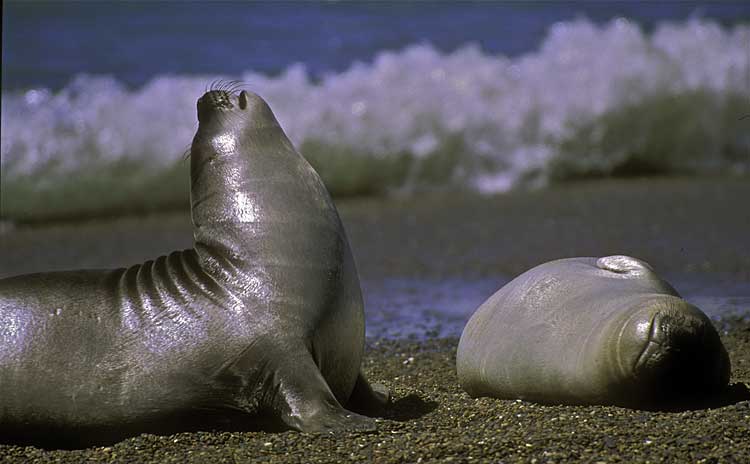IN DARWIN’S FOOTSTEPS (PART 1):
PATAGONIA’S WILD ATLANTIC COAST,
LOS GLACIARES NATIONAL PARK,
CAPE HORN & TIERRA DEL FUEGO
October 31-November 17, 2010
Dr. Dee Boersma, Carol Passera, Audrey Benedict, and Guest Lecturers
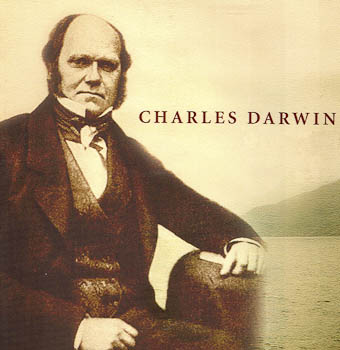 Charles Darwin’s theory of evolution—the multibranched “tree of life”—was such a dazzling leap in the history of science
that it tends to obscure the long tradition of scientific exploration that led up to it. The epic voyages of Captain James Cook and Alexander von Humboldt, clearly inspired the
H.M.S. Beagle’s brilliant commander, Captain Robert Fitzroy, and the ship’s aspiring naturalist, Charles Darwin. When the 22-year-old Darwin boarded the Beagle in 1831, embarking from England on a five-year circumnavigation of the world, no one could have guessed his unique potential to become one of the world’s great thinkers, a gifted observer of nature, and an extraordinarily intuitive geologist—or that the expedition would one day be considered the most important scientific voyage of all time. Darwin’s geological discoveries in Patagonia played a pivotal role in the development of his theory of evolution—his fossil evidence for earth’s greater antiquity challenging many of the leading scientists of his day. Charles Darwin’s theory of evolution—the multibranched “tree of life”—was such a dazzling leap in the history of science
that it tends to obscure the long tradition of scientific exploration that led up to it. The epic voyages of Captain James Cook and Alexander von Humboldt, clearly inspired the
H.M.S. Beagle’s brilliant commander, Captain Robert Fitzroy, and the ship’s aspiring naturalist, Charles Darwin. When the 22-year-old Darwin boarded the Beagle in 1831, embarking from England on a five-year circumnavigation of the world, no one could have guessed his unique potential to become one of the world’s great thinkers, a gifted observer of nature, and an extraordinarily intuitive geologist—or that the expedition would one day be considered the most important scientific voyage of all time. Darwin’s geological discoveries in Patagonia played a pivotal role in the development of his theory of evolution—his fossil evidence for earth’s greater antiquity challenging many of the leading scientists of his day.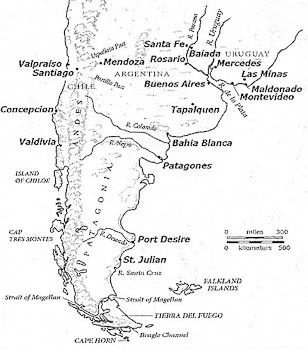
Darwin spent 20 years, following his return to England, working through the journals of the Beagle voyage, his notebooks, poring over his specimen collections, corresponding with fellow scientists, and conducting experiments—until a letter from fellow naturalist and evolutionary-theorist, Alfred Russel Wallace, compelled him to publish his seminal work, On the Origin of Species. That book, and several other works, placed Darwin squarely at the epicenter of Victorian scientific debate—launching what others would call the “Darwinian Revolution.” In exacting detail, he set forth the biological mechanisms responsible for the amazing diversity of life on earth, for variation within species, and for the geographic distribution of species and varieties—an unapologetic and unequivocal rebuttal of creationism. From a modern environmentalist’s perspective, the conceptual framework of Darwinian evolution should have laid to rest any lingering notion of human superiority—or that the earth was “created” solely for our benefit. In fact, were Darwin here today, he would remind us that humans represent but one tiny twig on an enormous and luxuriantly branching tree of life!
 In celebration of the 150th anniversary of Darwin’s Origin of Species, we embark on a unique Cloud Ridge voyage of discovery—to where the Darwinian Revolution began. This land and sea-based journey traces Darwin’s incredible explorations along the remote coastline of Argentine Patagonia, his geologic and biological forays into the Andean highlands, and concludes with four days spent cruising the glacier-carved fjords of Tierra del Fuego. In celebration of the 150th anniversary of Darwin’s Origin of Species, we embark on a unique Cloud Ridge voyage of discovery—to where the Darwinian Revolution began. This land and sea-based journey traces Darwin’s incredible explorations along the remote coastline of Argentine Patagonia, his geologic and biological forays into the Andean highlands, and concludes with four days spent cruising the glacier-carved fjords of Tierra del Fuego.
We begin our journey in Buenos Aires, touring the now-cosmopolitan city that Darwin so admired for its architectural beauty. Flying to Comodoro Rivadavia, we drive along the coast to Bahia Bustamante, a small town devoted to the processing of marine algae. We explore a coastline graced by white sand beaches and noisy colonies of sea lions, Magellanic penguins, the endemic Olrog’s gulls and flightless steamer ducks, and both rock and red-legged cormorants. There should also be opportunities to see the small Commerson’s dolphins, as well as orcas and southern right-whales. This coastline is a critical stop-over for migratory shorebirds, which stage here by the thousands.
Continuing “in Darwin’s footsteps,” we visit the marine outpost of Cabo Blanco, near Puerto Deseado, where you truly feel that “nowhere is a place.” 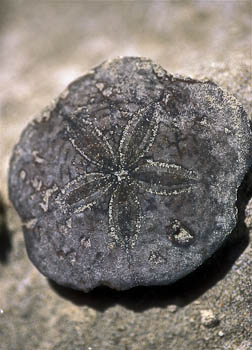 We’ll tour Petrified Forest National Park, where Darwin discovered the fossilized remnants of a once-flourishing tropical forest. Darwin’s journal devotes several pages to San Julian and the Rio Santa Cruz valley, where he discovered a vast fossilized seashore, remarkable for its giant oyster fossils, extending for more than 500 miles along the coast and then inland to at least 3,000 ft. in the Andean foothills. These fossil discoveries, among others, led Darwin to propose that the entire southern portion of South America must have been massively uplifted during, in his words, “some epoch of extreme violence.” We’ll tour Petrified Forest National Park, where Darwin discovered the fossilized remnants of a once-flourishing tropical forest. Darwin’s journal devotes several pages to San Julian and the Rio Santa Cruz valley, where he discovered a vast fossilized seashore, remarkable for its giant oyster fossils, extending for more than 500 miles along the coast and then inland to at least 3,000 ft. in the Andean foothills. These fossil discoveries, among others, led Darwin to propose that the entire southern portion of South America must have been massively uplifted during, in his words, “some epoch of extreme violence.”
We conclude our exploration of Patagonia’s wild coastline with a visit to Monte León National Park, the first coastal and maritime national park in Argentina. Preservation of this pristine coastal steppe landscape and it’s wildlife began as a conservation project funded by American ecophilanthropists Doug and Kris Tompkins, co-founders of Conservacion Patagonica. Transferred to the National Parks Administration in 2001, this spectacular park provides an almost complete sampling of Patagonia’s biodiversity— exactly as Darwin saw it! Species lists for Monte León report at least 134 species of birds, including the 5th largest colony of Magellanic penguins (±70,000 pairs), Darwin’s rhea, elegant-crested tinamou, and Chilean flamingo, as well as 28 mammalian species, including the mara, two species of armadillo, guanaco, puma, gray fox, and the almost mythical Patagonian possum.
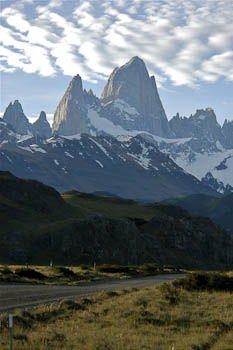 Turning our attention to Patagonia’s glacier country—the domain of the Andean condor—we’ll retrace Darwin’s journey up the Rio Santa Cruz, in search of it’s headwaters in the snowy Andean cordillera. Darwin was forced to turn back before reaching the glaciers or even the huge lakes— Lago Argentino and Lago Viedma—nourished by meltwater from the vast Southern Continental Icefield. In Darwin’s honor, we’ll visit Perito Moreno Glacier, Los Glaciares National Park’s most famous glacier and named for the region’s greatest scientist-explorer. Moving deeper into this glacier-carved wilderness, we’ll explore beautiful Andean beech forests and travel by small boat through a maze of blue icebergs to a trail that climbs to a dramatic view of the Upsala Glacier. Turning our attention to Patagonia’s glacier country—the domain of the Andean condor—we’ll retrace Darwin’s journey up the Rio Santa Cruz, in search of it’s headwaters in the snowy Andean cordillera. Darwin was forced to turn back before reaching the glaciers or even the huge lakes— Lago Argentino and Lago Viedma—nourished by meltwater from the vast Southern Continental Icefield. In Darwin’s honor, we’ll visit Perito Moreno Glacier, Los Glaciares National Park’s most famous glacier and named for the region’s greatest scientist-explorer. Moving deeper into this glacier-carved wilderness, we’ll explore beautiful Andean beech forests and travel by small boat through a maze of blue icebergs to a trail that climbs to a dramatic view of the Upsala Glacier.
Flying to Ushuaia, the world’s southernmost city, we begin our exploration of Tierra del Fuego with a visit to historic Estancia Harberton and Hammer Island, home to nesting Magellanic and gentoo 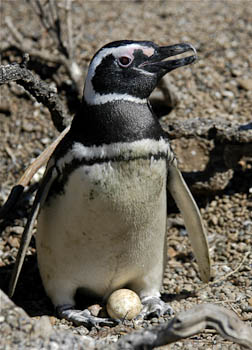 penguins. Our 4-day voyage aboard the Mare Australis promises far greater comforts than Darwin experienced aboard the Beagle. We’ll pass through Beagle and Murray channels, landing at legendary Cape Horn, on Islas Hornos. At Wulaia Bay, where Darwin landed in 1833, we’ll visit a former Yámana aboriginal settlement and hike through a stunning Magellanic forest. The opportunity to experience—by ship and Zodiac—the magnificent glaciers, tumbling waterfalls, and dramatic fjords of Tierra del Fuego is unparalleled. After navigating the legendary Strait of Magellan, our voyage of discovery concludes at Punta Arenas, Chile. “In Darwin’s Footsteps” is a true celebration of biodiversity! penguins. Our 4-day voyage aboard the Mare Australis promises far greater comforts than Darwin experienced aboard the Beagle. We’ll pass through Beagle and Murray channels, landing at legendary Cape Horn, on Islas Hornos. At Wulaia Bay, where Darwin landed in 1833, we’ll visit a former Yámana aboriginal settlement and hike through a stunning Magellanic forest. The opportunity to experience—by ship and Zodiac—the magnificent glaciers, tumbling waterfalls, and dramatic fjords of Tierra del Fuego is unparalleled. After navigating the legendary Strait of Magellan, our voyage of discovery concludes at Punta Arenas, Chile. “In Darwin’s Footsteps” is a true celebration of biodiversity!
Price: $7,100. (includes a $1,000 deposit)
Group Size: 14
Trip Rating: 2
Price Includes: 18 days/17 nights, including all hotel/airport transfers, all ground transportation, all lodging, 4-day cruise in Tierra del Fuego (Mare Australis), all meals, services of three naturalist leaders, local guides/lecturers, all national park and museum entrance fees, and gratuities as necessary.
Does not include roundtrip airfare (10/31-11/1 & 11/16-17) to Buenos Aires from your point of departure, internal flights/airport taxes (≈$385), or trip insurance. Trip cost is based on double occupancy; single supplement is $1525.
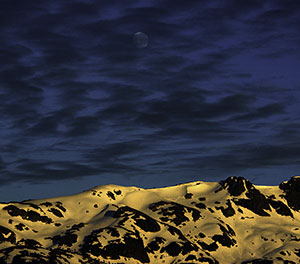
|
